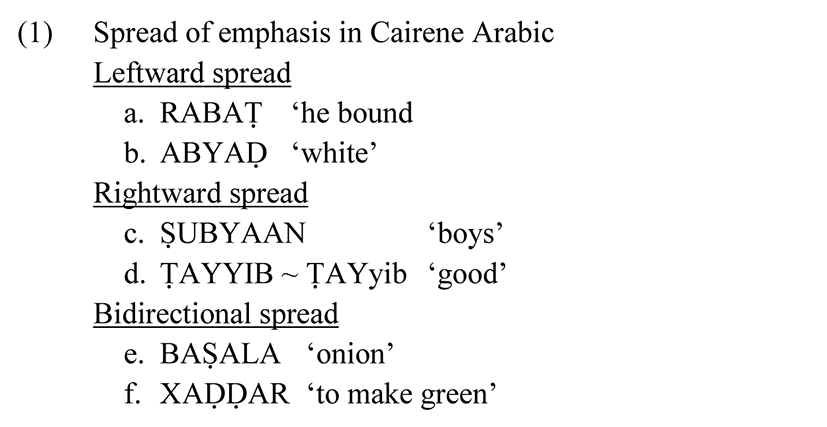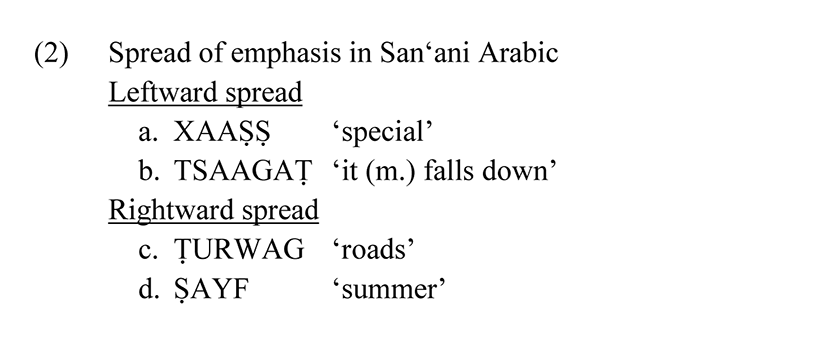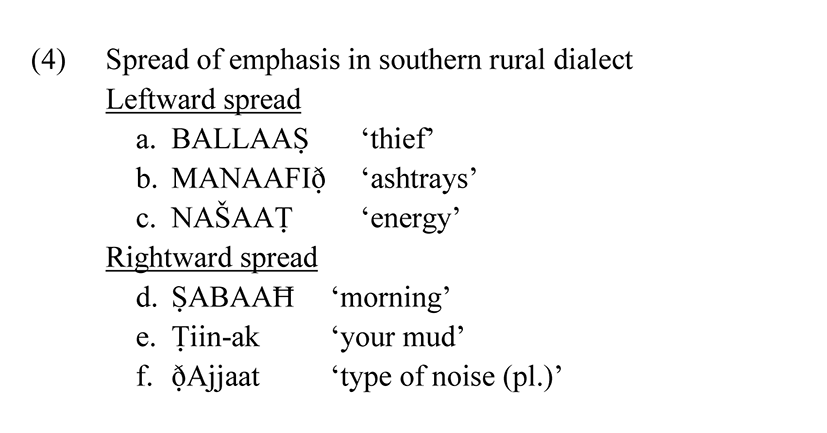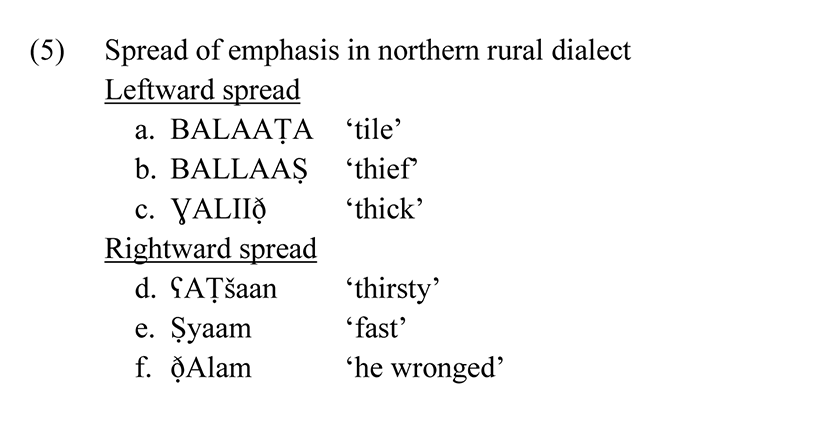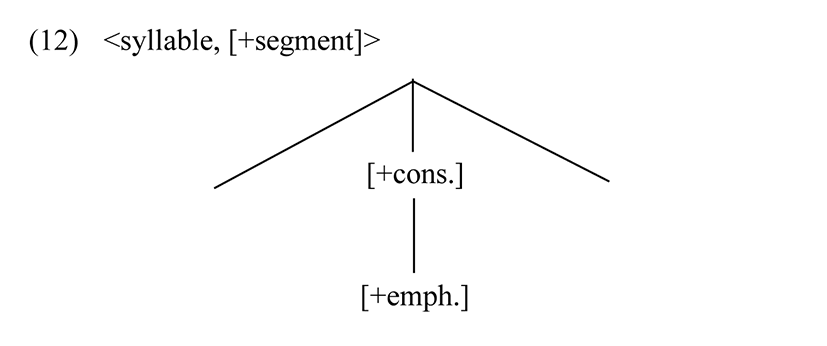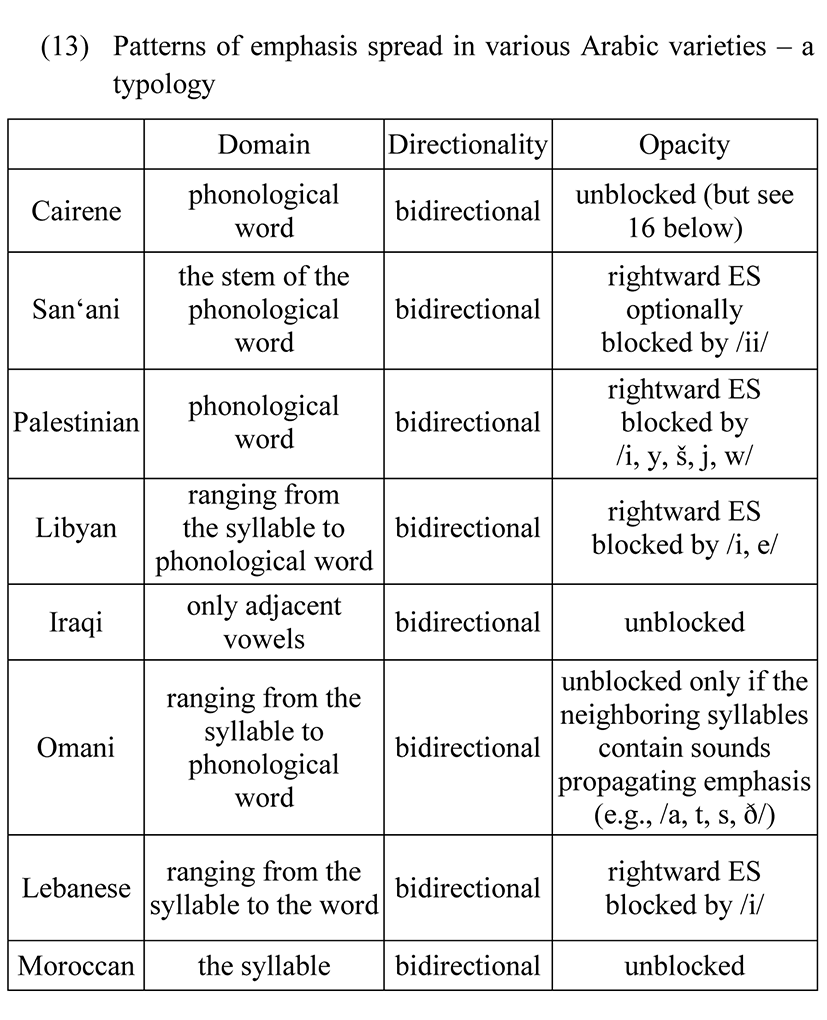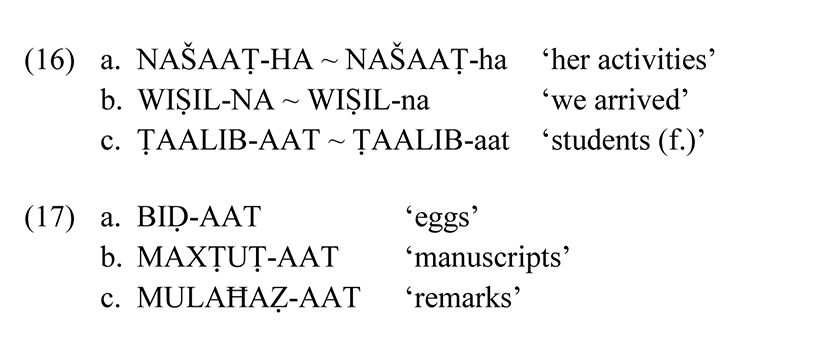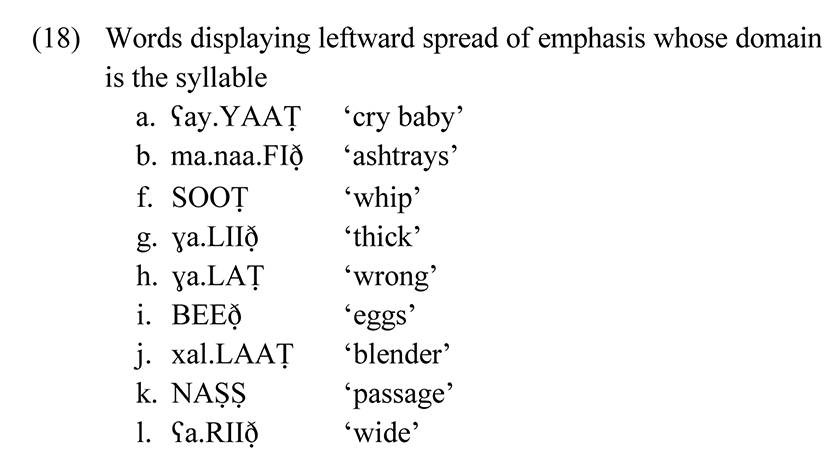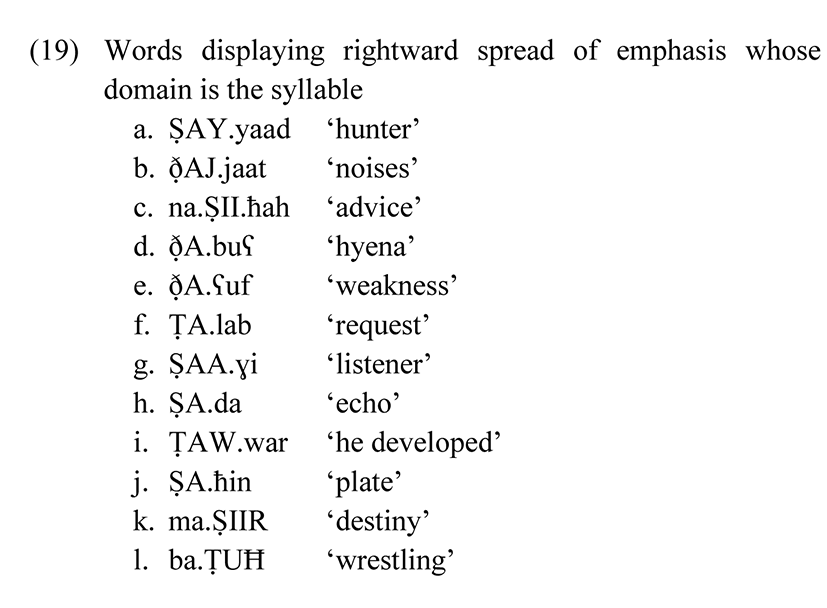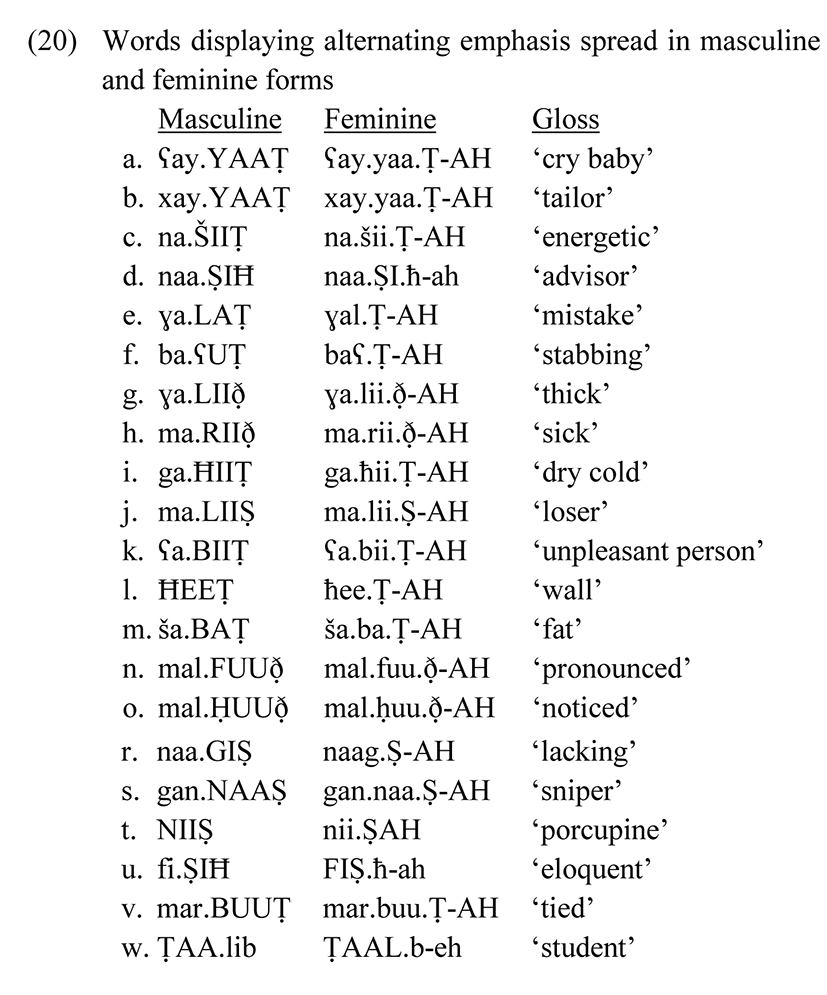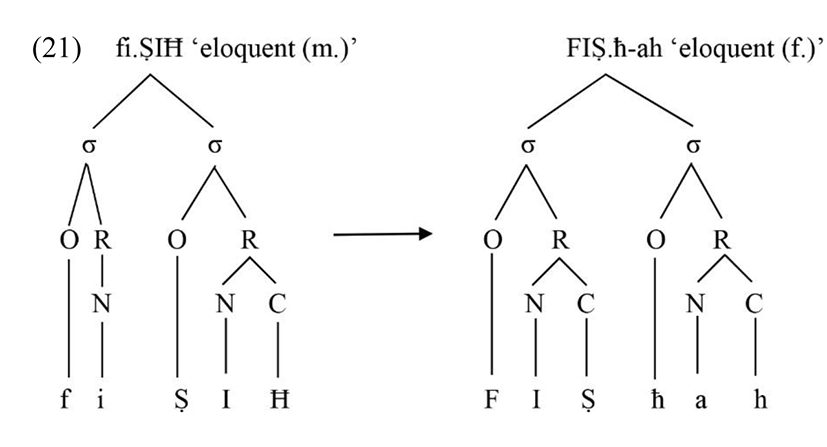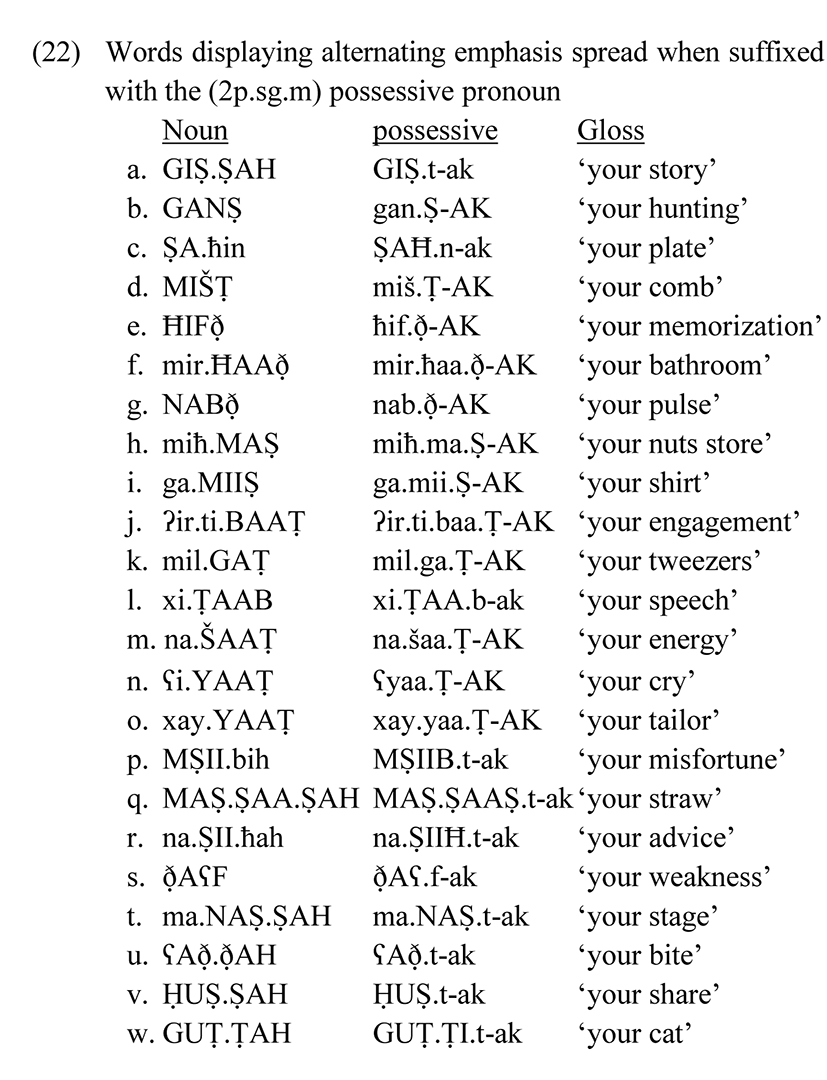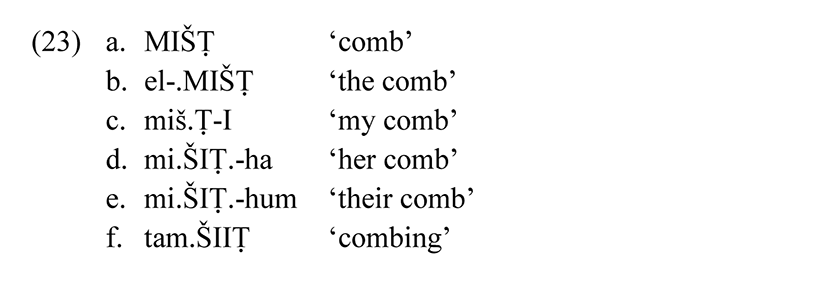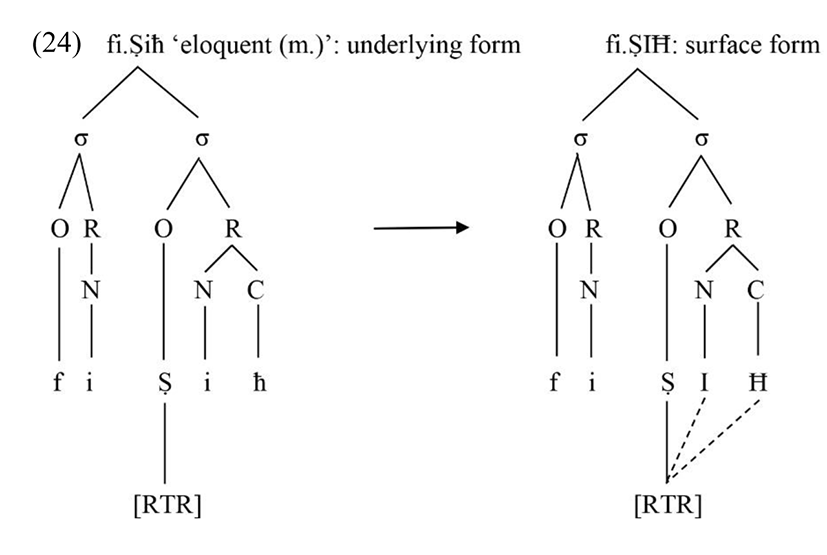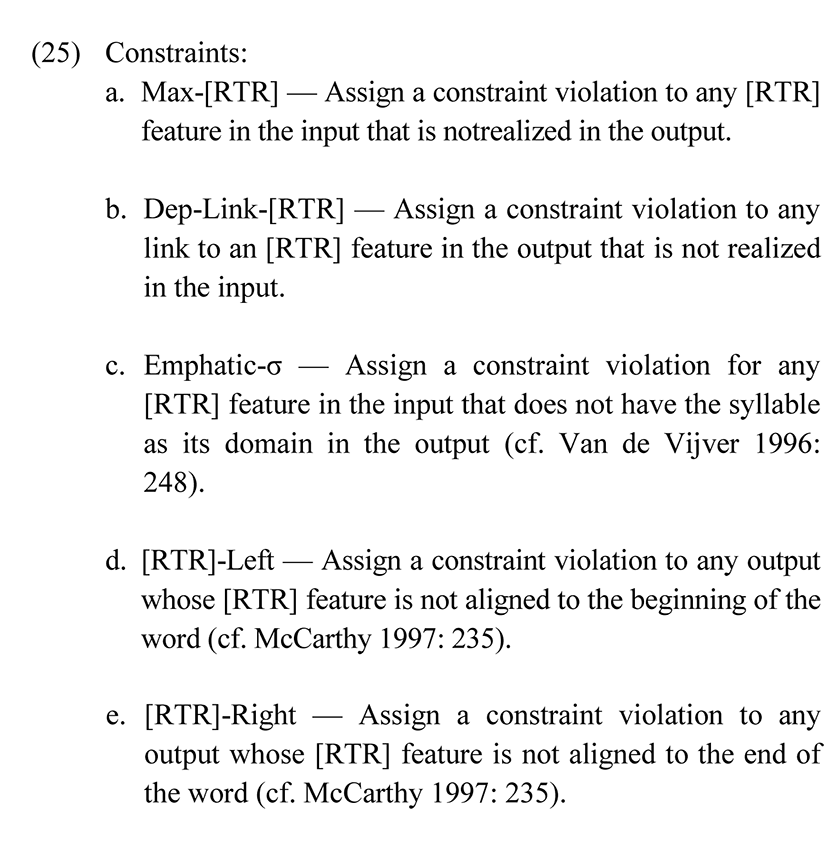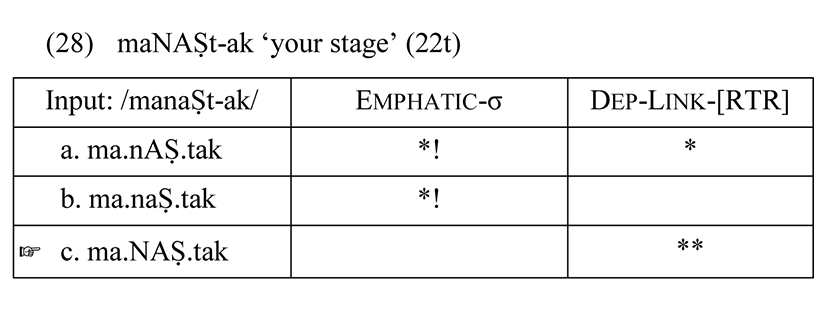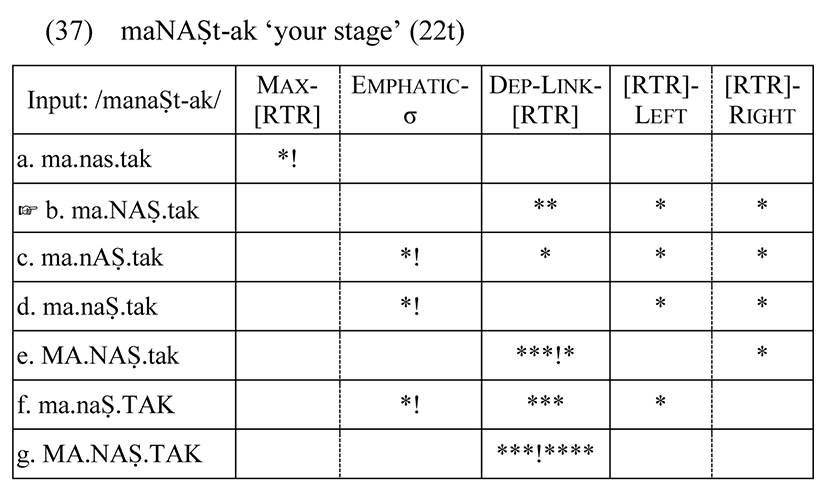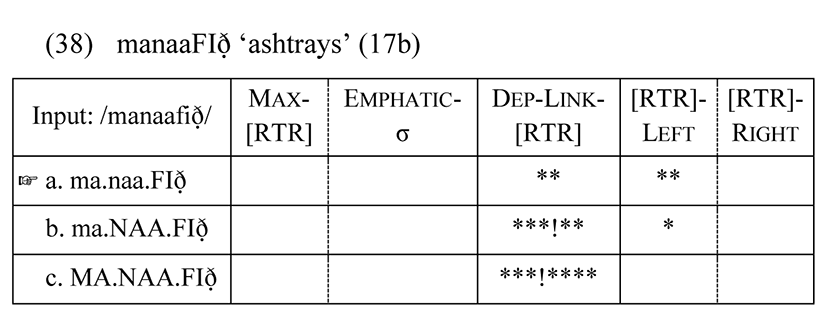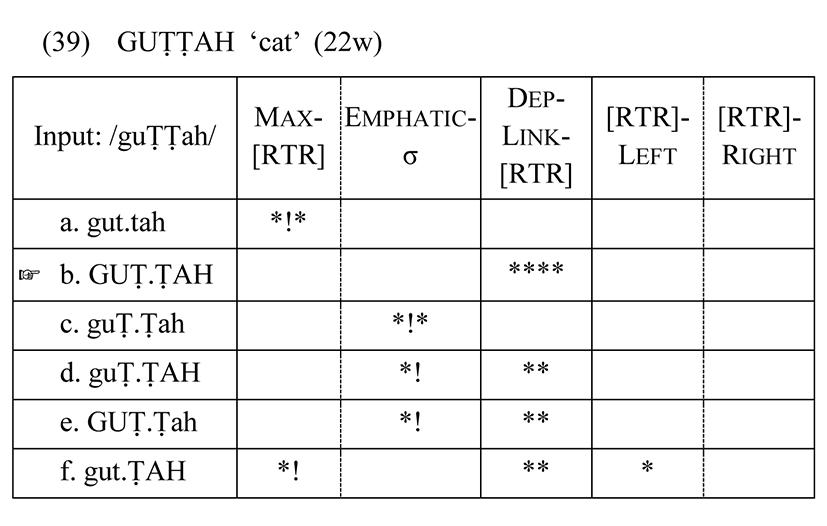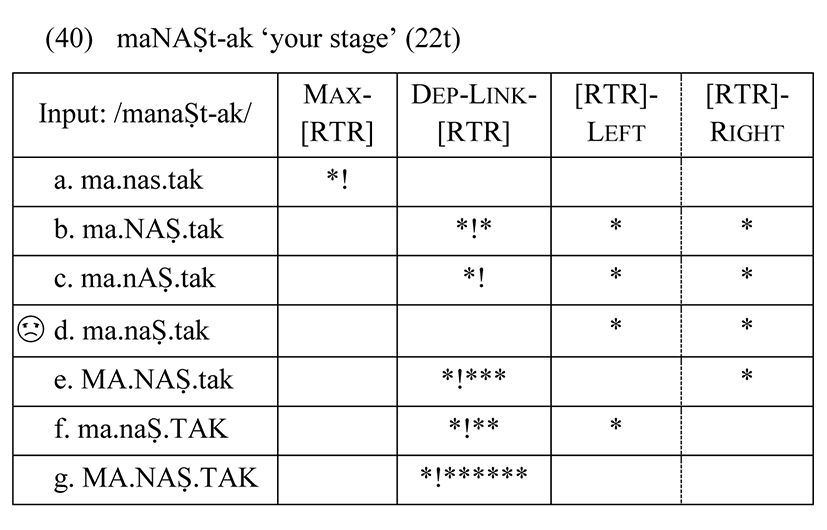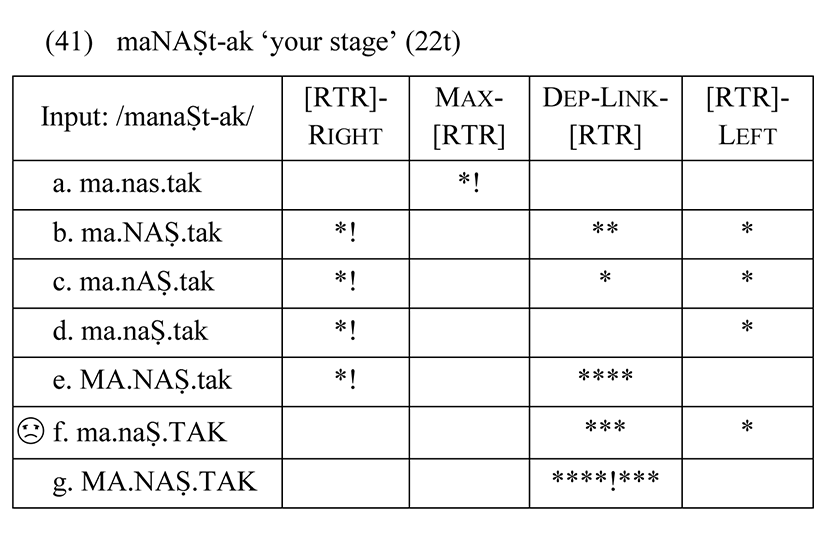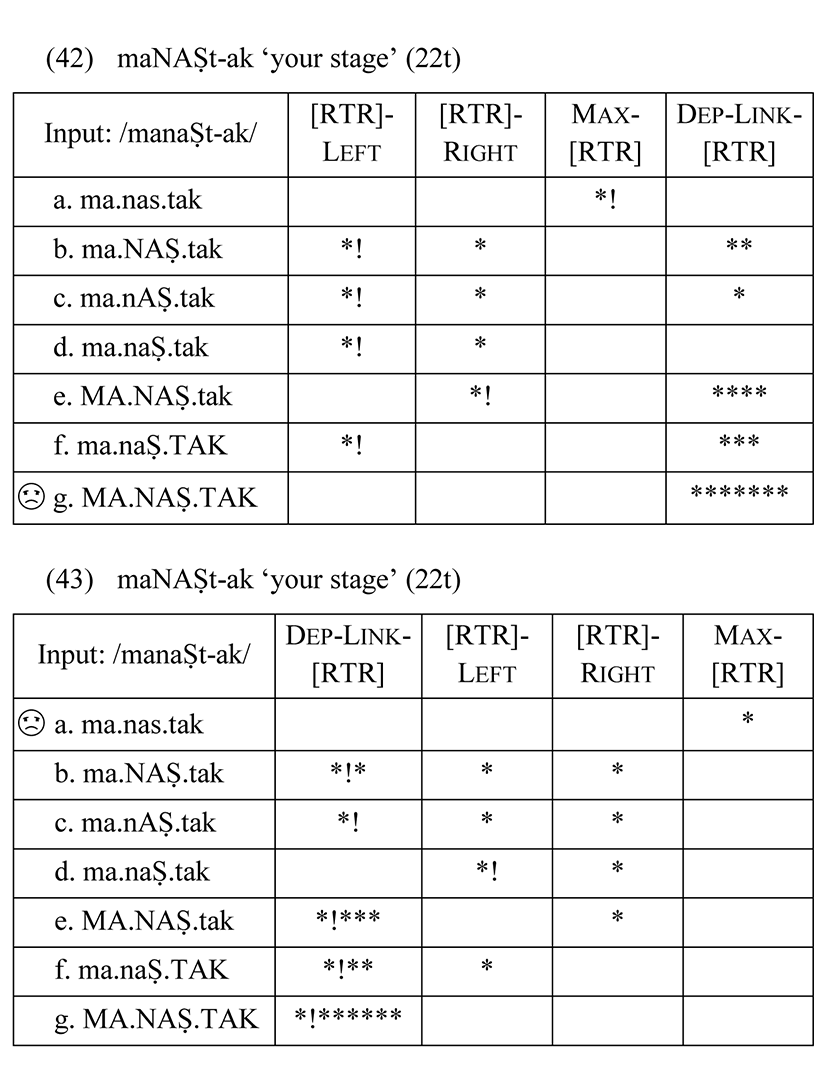1. Introduction
Modern Standard Arabic has four primary pharyngealized coronal consonants traditionally known as emphatics: (i) /ṣ/ (voiceless alveolar fricative), (ii) /ḍ/ (voiced alveolar stop), (iii) /ṭ/ (voiceless alveolar stop), and (iv) /ð̣/ (voiced interdental fricative). The production of these emphatic consonants involves a primary articulation at the dental or alveolar region and a secondary articulation whose characteristic feature is the constriction of the upper pharynx (McCarthy 1994: 219). It is this secondary articulation that distinguishes /ṣ/, /ḍ/, /ṭ/ and /ð̣/ phonologically from their plain (non-emphatic) counterparts /s/, /d/, /t/ and /ð/, respectively. That is, the former sounds have the distinctive feature RTR1, whereas the latter, as well as all the other segments, do not have such a feature (Davis 1995).
As far as pharyngealization is concerned, Arabic colloquial varieties differ primarily in two ways. First, some varieties may have the four underlying emphatic consonants (/ṣ/, /ḍ/, /ṭ/ and /ð̣/) like some Palestinian dialects spoken in Jordan, while some others like Iraqi (see Al-Ani 1970) and the rural Jordanian Arabic under study possess three emphatics, namely, /ṣ/, /ṭ/ and /ð̣/. In the latter dialects, /ḍ/ and /ð̣/ historically merged into a single emphatic sound realized as /ð̣/. Second, the pharyngealization component of the emphatic consonant can influence the pronunciation of other neighboring sounds; i.e., the emphatic feature [RTR] may spread onto other segments, including consonants and vowels, via assimilation. This phenomenon, however, may vary from one Arabic variety to another. For example, pharyngealization or ES may affect the entire word (Davis 1995, Watson 1999) or only adjacent vowels (Younes 1991, Al-Masri 2010); Such patterns of ES are abundantly discussed in the literature. Nevertheless, in a subvariety of rural Jordanian Arabic spoken in the district of Al-Mazar, there is an interesting phenomenon where the domain of ES is always the syllable containing an underlying emphatic. Although many linguists have explored ES in several Arabic dialects, there are no studies, to our knowledge, on the ES in the rural Jordanian subvariety under investigation. Additionally, Optimality-Theoretic studies on ES in Arabic, which are a few, are concerned with other patterns of ES in other Arabic varieties (i.e., not the syllable-bounded ES), such as the studies by Van de Vijver (1996) and McCarthy (1997) on the southern and northern Palestinian dialects, and Youssef (2013)’s study on Cairene Arabic. To this end, the present study undertaken here is significant in that it aims to uncover the prevailing pattern of ES in a subvariety of rural Jordanian Arabic, and then to analyze it within the framework of Optimality Theory (OT).
This article is structured as follows. Section 2 introduces background to our focus on rural Jordanian Arabic by presenting a typology of pharyngealization (ES) in Arabic dialects based on previous literature. Section 3 sets forth the pattern of ES in the subvariety of rural Jordanian Arabic under consideration and lays out the assumptions made about this phenomenon. Section 4 provides an optimality-theoretic analysis of the ES in that subvariety. Finally, Section 5 offers concluding remarks.
2. Typology of Pharyngealization in Arabic Dialects
Emphasis, or pharyngealization, has long been the center of attention in Arabic phonology. Emphasis is characterized by the retraction of the tongue root and increased tension of the pharyngeal musculature. For that reason, emphatics are noticeably more fortis than plain segments (Lehn 1963). Acoustically, emphatic consonants and their plain counterparts are generally distinct from each other. One of the detected differences between the consonants targeted by ES and those that are not concerns the formant transitions from consonants to vowels or vice versa (Norlin 1987). Another important difference concerns the VOT, which tend to be longer in a plain consonant than in an emphatic. For example, it has been found in Baghdadi Arabic that /t/ is voiceless aspirated with VOT values approximately double those of the voiceless unaspirated pharyngealized /ṭ/ (Heselwood 1996, Bellem 2007). Vowels targeted by emphasis should also be distinguished acoustically from plain vowels in that the former have a lower F2 than the latter (Card 1983, Shahin 2002).
Aside from the emphatic/plain distinction, Arabic dialects exhibit variation with respect to the spread of emphasis, such that one can posit a typology of ES among Arabic dialects. Specifically, the directionality and domain of ES differ considerably from one Arabic dialect to another. Emphasis may spread from the underlying emphatic consonant onto the neighboring vowels only over a certain number of open syllables in multi-syllabic words (Ali & Daniloff 1972) or it may spread over the entire word (Younes 1993; Davis 1993, 1995; Watson 1999) depending on the dialect. For instance, in Abha Arabic (a dialect spoken in the southwestern part of Saudi Arabia) emphasis customarily affects the adjacent vowel (Younes 1991), whereas in Cairene Arabic the domain of emphasis is normally the whole word (Youssef 2013). The spread might even extend over word boundaries as in Qatari Arabic (Watson 1999). In what follows, we will present in more detail the phonological patterns of ES in some Arabic dialects discussed in the literature.
In Cairene Arabic the four primary coronal emphatics (/ṣ, ḍ, ṭ, ẓ/) spread emphasis bidirectionally within the phonological word stem (Watson 2002).2 CV is the minimum domain of spread (Broselow 1976, cited in Watson 2002), while the phonological word is the maximum domain. Below are some clarifying examples (the data in(1) are from Watson 2002: 274-275). (In the transcription system employed in this study we follow Davis (1995). The underlying emphatics are represented by a dot underneath the letter, surface pharyngealized sounds (the target of emphasis) are represented by capital letters, a voiced palatoalveolar affricate by the symbol /j/, and short vowels are represented by one vowel and long vowels by two.)
Rightward spread, unlike leftward spread, may be optionally blocked within the stem by dorsal vocoids like /y/ and /i/, as seen in (1d) (see Watson (2002) for detailed information).3 Contrary to this view, Schulte (1985) and Youssef (2013) argue that neither leftward nor rightward ES is blocked in Cairene, which makes all the segments potential targets in the word domain. We follow this latter view of ES in Cairene Arabic, but noting the optionality discussed in (16) below.
Another dialect exhibiting ES is San‘ani Arabic (Watson 2002). In this dialect, emphasis also spreads leftward and rightward within the stem of phonological words, as illustrated in (2a)-(2b) and (2c)-(2d), respectively (the following examples are from Watson (2002: 280)).
Emphasis spreading into affixes normally fails even if they are in the syllable containing an emphatic, as demonstrated in (3) (from Watson (2002: 280-281)).
It is worth noting that rightward spreading is also more restricted than leftward spreading in San‘ani Arabic.
Similarly, ES is also observed in Palestinian Arabic. Davis (1995) analyzed ES in two Palestinian dialects (a southern and a northern rural dialect) through adopting the Grounded Phonology approach. By incorporating aspects of this approach, his analysis accounts for different sets of opaque phonemes in these two dialects as well as for the difference between leftward and rightward spread. In the southern rural dialect, which has /ṣ/, /ṭ/ and /ð̣/ as prevalent primary emphatic phonemes and /ẓ/ as marginal, leftward ES conspicuously differs from its rightward counterpart in that the former, unlike the latter, is unrestricted, as illustrated by the data in (4a)-(4c) and (4d)-(4f), taken from Davis (1995: 473-474).
Similarly, the leftward spread, unlike rightward spread, is also generally unrestrained in the northern rural Palestinian dialect, as indicated in (5a)-(5c) and (5d)-(5f), respectively (the data are from Davis (1995: 484-485)).
For detailed information concerning the variation between the two types of ES in the two Palestinian dialects discussed above, the reader is referred to Davis (1995).
A dialect portraying a relatively different pattern of ES is Libyan Arabic (Algryani 2014). The domain of the emphasis in leftward spreading, as Algryani argues, can generally be either the entire phonological word or the syllable, as seen in (6) (the dot between letters is used to mark syllable boundary).
This, however, does not fully apply to rightward spreading which seems to be blocked by /i/ and /e/, as shown in (7) (see Algryani (2014) for details and Slimani (2018) for a similar pattern in Djelfa Algerian Arabic).
Thus far, we have seen that ES may vary considerably from one Arabic variety to another. Generally, rightward spreading in Cairene, San‘ani, southern and northern Palestinian dialects, and Libyan is much more complicated than leftward spreading as the former is susceptible to blocking. Nonetheless, in the dialects discussed above we can maintain that the phonological word is the domain for ES with various conditions on blocking. While our discussion focuses on the formal aspects of ES, it should be noted that functionally ES serves as an important cue for processing words in rapid speech (see Davis & Baertsch 2012 for discussion on unifying formal and functional explanations in phonology).
Aside from the above analyses of ES, several linguists argue that the syllable may be the target of ES in some Arabic varieties. In Iraqi Arabic, for example, only open syllables (e.g., CVV) are said to be the domain of emphasis in both monosyllabic and disyllabic words (Ali & Daniloff 1972). By comparison, emphasis in Omani Arabic unconditionally spreads to the whole syllable in monosyllabic words (Shaaban 1977), as shown in (8).
Nonetheless, emphasis in disyllabic words may, but need not, coincide with syllabic boundaries, as seen in the examples in (9).
Note that the domain of emphasis in (9a)-(9b) is the syllable, whereas emphasis in (9c) extends beyond the syllable boundary. Shaaban argues that low vowels (e.g., /a/), unlike other vowels (e.g., /i/), strongly tend to propagate emphasis beyond the syllable containing the emphatic consonant. It is worth noting that regressive ES also follows the general principles of progressive ES.
The syllable as the domain of emphasis is more predominant in Lebanese Arabic. In this dialect, the syllable is the basic domain (Obrecht 1968), as seen in (10) below.
However, ES may occasionally cross syllable boundaries in CVC̣V structures (e.g., WA.RAʔ). Obrecht provided only a few examples of ES and did not elaborate much on this topic. Thus, it is not clear what the other less common domains of ES are in Lebanese Arabic. The crucial point here is that the syllable is the basic, but not the only, domain of emphasis. This is also the case in three Jordanian subvarieties: Kufr El-ma’ (Bani-Yasin & Owens 1987), Wadi Ramm (Al-Mashaqba 2015), and Juffin (Huneety & Mashaqba 2016). The syllable, however, is reported to be the only domain of ES in Moroccan Arabic (Sayed 1981), as exemplified below.
The distribution of the [+emphatic] feature to other segments within the syllable domain can be captured by the following diagram in (12) (from Sayed 1981: 146).
This diagram, according to Sayed, shows that the presence of an underlying emphatic in a syllable entails the assignment of the [+emphatic] feature to the node dominating that emphatic segment and the spread of that feature to the rest of the segments that are dominated by the same syllable node. Sayed does not elaborate much on this as he puts more focus in his analysis on the syllable structure rules. He, however, made it clear that the domain of ES in Moroccan Arabic is the syllable. We will also see below that the domain of ES in the rural Jordanian dialect under study is unexceptionally the syllable, which makes the Jordanian and Moroccan dialects distinct from the other dialects discussed above.
To recapitulate, the table in (13) presents a synopsis of the similarities and differences in the patterns of ES among the Arabic varieties discussed above with respect to the domain, directionality and opacity of ES. This table encapsulates a typology of ES in Arabic dialects.
Thus far, we have looked at different domains of ES in various Arabic dialects, but nothing has been said about whether the [RTR] feature that characterizes pharyngealization is a property of the emphatic segment or of the domain itself. It has been argued by Lehn (1963) that the syllable is the prosodic domain of ES. Accordingly, emphasis in Cairene Arabic is suggested to be a constituent of the syllable rather than of individual emphatic segments (Lehn 1963). Although the CV sequence is suggested to be the minimum domain of ES and the utterance its maximum domain, it is proposed that “the distribution of emphasis in utterances is most readily expressed in terms of the syllable” (Lehn 1963: 37). This is so because utterances consist of sequences of syllables, after all. Below are some illustrative examples taken from Lehn (1963: 38).
Nonetheless, Davis (1991) disagrees with Lehn (1963)’s argument for two main reasons. First, Davis argues that Lehn groups the emphatic /Ṛ/ with the underlying emphatics /Ṣ, Ḍ, Ṭ, Ẓ/ and Lehn’s analysis is largely based on utterances containing /Ṛ/. Davis indicates that Lehn’s classification of emphatics obscures the patterns of ES in Cairene Arabic and therefore /Ṛ/ should be differentiated from /Ṣ, Ḍ, Ṭ, Ẓ/ because the former, unlike the latter, morphophonemically alternates with its non-emphatic counterpart, as shown in (15) below.
Additionally, Davis notes, following Younes (1991), that the emphatic /Ṛ/, unlike the underlying emphatics, is affected by de-emphaticization rules in Cairene as well as in other Arabic dialects. For these reasons the sound /Ṛ/ can be considered a secondary emphatic and will not be further discussed in this paper.
Second, Davis contends that how emphasis spreads into suffixes varies, depending on the location of emphatic sounds and the type of suffix itself, as clarified by the following examples taken from Davis (1991: 5) for Cairene Arabic.
As seen above, the spreading of emphasis into the suffix is optional in (16a)-(16c), but obligatory in (17a)-(17c). Emphasis obligatorily spreads into a vowel-initial suffix (e.g., the feminine plural marker-aat) only if the suffix is attached to a word ending in an emphatic, as in (17a)-(17c). That the pharyngealization of suffixes is optional in (16) but obligatory in (17), according to Davis, suggests that the emphatic feature is part of the phoneme rather than the morpheme. Therefore, in order to distinguish between different cases of ES like those in (16a)-(16c) and (17a)-(17c), it should be assumed that the emphatic feature must only be associated with the individual consonant, but not with the syllable, contra Lehn’s claim. This is the argument we are adopting in our analysis of ES in the rural Jordanian subvariety to be discussed below. Having presented a typology of ES in Arabic dialects in this section, we turn to a detailed description of ES in a previously undescribed rural Jordanian Arabic variety in Section 3 with an optimality-theoretic analysis in Section 4.
3. Emphasis Spread in Rural Jordanian Arabic
In the rural Jordanian dialect under study, there are only three underlying (classical) emphatics, namely, /ṣ/, /ṭ/ and /ð̣/. The fourth emphatic /ḍ/ from Classical Arabic is always realized as /ð̣/, as alluded to earlier. This dialect exhibits a different and rather consistent phonological behavior of ES in such a way that emphasis spreads onto other segments only within the syllables having an underlying emphatic.4 The following examples illustrate this point. (Note that all the data presented in this section are based on the first author’s speech.).
The above data show that emphasis spreads leftward only within the syllable domain. Identically, the phonological behavior of rightward ES also targets the syllable as its domain, as indicated by the following examples.
Note that all the segments in the syllables that include underlying emphatics acquire the [RTR] feature in this dialect. Additionally, this pattern of syllable-bounded ES is unblocked in either direction, as seen in (18)-(19). To further check the consistency of this paradigm of ES, let us consider what happens to ES in re-syllabified words. That is, we want to see how ES alternates when the underlying emphatics are repositioned in words owing to affixation. This is manifestly exhibited in words suffixed with the feminine marker -ah, as clarified by the data in (20).5
Any syllable with an underlying emphatic, as we can see in (20) above, receives ES, irrespective of the change in the syllable structure induced by re-syllabification. The following schematization of (20u) further elucidates the alternation of ES among syllables. (σ stands for syllable, O for onset, R for rhyme, N for nucleus, and C for coda.).
In fi.ṢIĦ ‘eloquent (m.)’, the underlying emphatic /Ṣ/ constitutes the onset of the second syllable and therefore [I] and [Ħ] of the very same syllable become emphaticized. The segments /f/ and /i/ are not affected by ES since they are located in another syllable. By considering the ES in FIṢ.ħ-ah ‘eloquent (f.)’, in comparison, we can see that /Ṣ/ occupies the coda of the first syllable due to the suffixation of the feminine marker -ah. As a result, the segments of the first syllable ([F] and [I]) are affected by ES since they are part of the very same syllable containing /Ṣ/. /ħ/ which was emphatic (realized as [Ħ]) in fi.ṢIĦ is no longer emphatic in FIṢ.ħ-ah after the re-syllabification process has taken place. It must be borne in mind that the same process also applies to all the other examples in (20). That is, any re-syllabification of words results in shifting the spread of emphasis from one syllable to another along with the underlying emphatic.
Similarly, the re-syllabification of words triggered by the suffixation of the second person singular masculine (2p.sg.m) possessive pronoun (-ak) also has the same effect, namely, pharyngealizing the syllable with the underlying emphatic, as illustrated by the following examples.
The data in (22) show how adding the suffix -ak also brings about an alternation of ES among syllables. In fact, adding any other affixes (e.g., the first person singular possessive pronoun -i ‘my’) will still give rise to the same phenomenon, namely, having the syllable as the only domain of ES, as further clarified by the following examples.
Crucially, any alternation of the syllable structure induces the same effect, i.e., having the syllable-bounded ES. Finally, yet importantly, if a disyllabic word has an emphatic geminate like the examples in (22t)-(22w) above, both syllables undergo emphasis because the first part of the geminate is the coda of the first syllable and the second is the onset of the second syllable. Overall, all the above examples indicate the uniformity of the syllable-bounded ES, irrespective of the directionality of spreading.6 In the following section, we will provide an OT analysis of the phonological behavior of the syllable-bounded ES in question. We will show that the emphatic syllable is the optimal surface form in this dialect.
4. Optimality-Theoretic Analysis
Before offering an optimality-theoretic analysis of syllable-bounded ES, we would like to further elucidate the underlying assumptions of ES adopted here. First, ES in the rural Jordanian dialect in question, as seen in the data in (18)-(20) and (22)-(23) above, has the syllable as its domain. The ES is then bidirectional and unimpeded within the syllable domain. That is, no sounds may block the ES in this subvariety, unlike the situation in other Arabic varieties. Besides, all the non-emphatic sounds, without exception, may potentially be the target of ES if located within the syllable containing an underlying emphatic. The sounds impacted by ES are the only ones that acquire the [RTR] feature, while the rest of the sounds (the unaffected ones) do not. This means that [RTR] is privative in our analysis since this feature has only one value; i.e., a sound is either [RTR] or not. Second, the syllable, which is the only target of ES in this dialect, is one of the prosodic constituents in Arabic (see McCarthy & Prince 1990). Although the syllable is manifestly the domain of ES in the rural Jordanian Arabic under study, the emphatic feature is by no means a component of the syllable. Rather, this feature is only part of individual emphatic segments, but its domain of spreading turns out to be the syllable (the unmarked structure). Third, this type of ES can be conceptualized within autosegmental phonology (cf. Goldsmith 1976). That is, when the linking of the [RTR] feature occurs, [RTR] is mapped onto all the segments within the targeted syllable domain. This may be represented by the insertion of association lines between the [RTR] feature of the underlying emphatic and each of the affected segments, as schematized in (24) below.
Among the association lines between [RTR] and the segments in the syllable [ṢIĦ], the solid line indicates that /Ṣ/ is underlyingly [RTR], while the dash lines indicate that /I/ and /Ħ/ acquired [RTR] via assimilation. In other words, after ES takes place within the syllable containing /Ṣ/, the [RTR] as a result becomes associated with both /I/ and /Ħ/.
Having presented the nature of the linking of [RTR] in this Jordanian dialect, let us now turn to the OT analysis of the syllable-bounded ES under study. We will begin first by introducing the faithfulness and markedness constraints that we will need for this type of analysis. The former constraints necessitate that the underlying and surface forms be identical (cf. McCarthy & Prince 1995, 1999), while the latter favor surface forms with unmarked structures. The faithfulness and markedness constraints at work in our analysis are given in (25) below. (For other recent work on Optimality Theory, see Omachonu 2008, Dutta 2012, Nguyen & Dutta 2017, and Ghorbanpour et al. 2019.).
The constraint in (25a) is a faithfulness constraint that militates against any underlying emphatic surfacing as non-emphatic in the output (do not delete the [RTR] feature). The constraint in (25b) is also a faithfulness constraint that militates against any underlyingly non-emphatic segments surfacing as emphatic by way of spreading of [RTR] (do not add additional association lines linked to [RTR]). The constraint in (25c), on the other hand, is a markedness constraint requiring that any syllable containing an underlying [RTR] be emphatic meaning that the domain of [RTR] in surface forms be coextensive with the syllable. Likewise, the constraint in (25d) is a markedness constraint that requires that the [RTR] feature spread leftward from an emphatic segment until the beginning of the word. Finally, the constraint in (25e) is also a markedness constraint but requires rightward spreading of the [RTR] feature from an emphatic segment to the end of the word. In McCarthy’s analysis, every single non-emphatic sound that fails to acquire the [RTR] feature in the output incurs one violation of [RTR]-Left/Right so that the violations may be many, depending on the number of segments, if [RTR] does not align initially or finally in the word. Nevertheless, in our analysis of this rural Jordanian dialect, any violation of RTR-Left/Right is evaluated, not with respect to the segment, but with respect to the syllable; i.e., each syllable in which [RTR] is not aligned initially or finally in a word incurs one violation.
Let us now examine how the aforementioned constraints produce the correct outcomes. We first want to consider how each of the constraints interacts with the other on a one-to-one basis, and then look into the resulting ranking that gives rise to the optimal outputs, namely, the structure with syllable-bounded ES. That is, we first establish the ranking between each pair of conflicting constraints, and then present the final ranking of all the constraints at work. To begin with, let us consider the relationship between MAX-[RTR] and DEP-LINK-[RTR] in the tableau in (26) below.
The candidate in (26a) in the above tableau loses out to candidate (26b) as the former incurs a fatal violation of the high-ranked constraint MAX-LINK-[RTR]. In contrast, candidate (26b) wins out because it respects the higher ranked MAX-[RTR] and violates the lower ranked constraint DEP-LINK-[RTR]. Here we have a categorical ranking of these two constraints given in (27) below.
The former constraint in (27) unequivocally outranks the latter simply because the reverse order of their hierarchy favors the losing candidate. What this means is that an underlyingly emphatic phoneme cannot lose its [RTR] feature. A second constraint that outranks DEP-LINK-[RTR] is EMPHATIC-σ, as shown in the tableau in (28) below.
As seen in the above tableau, the emphatic feature in candidate (28a) only spreads onto the preceding vowel. This candidate however is ruled out due to its fatal violation of the high-ranked EMPHATIC-σ since the entire second syllable is not emphatic. The faithful candidate in (28b) is also disfavored because it violates EMPHATIC-σ. Candidate (28c), in contrast, is the optimal output as it only violates the lower ranking DEP-LINK-[RTR]. Should the ranking of these two constraints be reversed, the winning candidate in (28c) will be excluded. Thus, the [RTR] feature has to be realized on all the phonemes of a syllable. The ranking arrived at so far is illustrated in (29) below.
Both MAX-[RTR] and EMPHATIC-σ are clearly ranked higher than DEP-LINK-[RTR]. There is no indication of any evidence that can determine the hierarchy between the former two constraints, as demonstrated in the tableau in (30).
The constraint hierarchy cannot be ascertained here because reversing the ranking of the two constraints in the above tableau will still yield the same result, namely, favoring candidate (30b) as the winner. Both constraints are undominated in the Jordanian dialect in question.
Let us now see how the rest of the constraints fit into this hierarchy, namely, [RTR]-LEFT and [RTR]-RIGHT. The interaction between the former constraint and EMPHATIC-σ is shown in the tableau in (31) below.
Candidate (31a) is disfavored and hence eliminated because it violates the higher ranked EMPHATIC-σ. It violates this constraint since the domain of emphasis is not coextensive with the syllable containing the emphatic sound. Candidate (31b), in contrast, is the optimal output as it only violates the lower ranked [RTR]-LEFT. Accordingly, EMPHATIC-σ outranks [RTR]-LEFT. [RTR]-RIGHT is also categorically outranked by EMPHATIC-σ, as demonstrated in the tableau in (32).
Given that the domain of emphasis in (32a) is not coextensive with the syllable, candidate (32a), unlike the optimal output in (32b), is excluded due to its violation of the high ranking EMPHATIC-σ. Any change in the ranking in the tableaux in (31) and (32) will tip the balance in favor of the losing candidates. The constraint hierarchy established in the above two tableaux is provided in (33).
There is also a direct interaction between DEP-LINK-[RTR] on the one hand and [RTR]-LEFT and [RTR]-RIGHT on the other hand. This is evidenced by the tableaux in (34) and (35). (In these tableaux the constraint EMPHATIC-σ is respected by both candidates because of the syllable-bounded ES. This then can show the ranking between the DEP-LINK-[RTR] constraint and the align-[RTR] constraints.).
Tableau (34) makes explicit the categorical ranking of DEP-LINK-[RTR] over [RTR]-LEFT. Candidate (34a) incurs four violations of the higher ranked DEP-LINK-[RTR], but respects [RTR]-LEFT. Notwithstanding this, it fails to surface. Candidate (34b), by comparison, surfaces as the optimal output since it only violates DEP-LINK-[RTR] twice. The reversed ranking of the two constraints will favor the losing candidate. Concerning [RTR]-RIGHT, it is also dominated by DEP-LINK-[RTR] as illustrated in the tableau in (35).
As seen above, DEP-LINK-[RTR] evidently outranks [RTR]-RIGHT. Given this, candidate (35a) loses out to candidate (35b) since the former has more violations of the higher ranked DEP-LINK-[RTR] than the latter. Since MAX-[RTR] and EMPHATIC-σ both dominate DEP-LINK-[RTR], and since DEP-LINK-[RTR] dominates both [RTR]-LEFT and [RTR]-RIGHT, then by transitivity MAX-[RTR] and EMPHATIC-σ must dominate [RTR]-LEFT and [RTR]-RIGHT. The final ranking of all the five constraints is displayed in (36).
This ranking is represented in the following comprehensive tableau that includes all the candidates and constraints examined above.
In the tableau in (37), candidate (37a) is ruled out because of its fatal violation of the high-ranked constraint MAX-[RTR]. Candidates (37c), (37d) and (37f) are eliminated due to their fatal violation of EMPHATIC-σ. Candidates (37e) and (37g) are also excluded since the former incurs four violations of DEP-LINK-[RTR] and the latter seven violations. Finally, the winning output is candidate (37b) as it satisfies the high-ranked constraints and minimally violates lower-ranked constraints. Needless to say, there is no evidence of any clear ranking between the lowest ranked [RTR]-LEFT and [RTR]-RIGHT based on the given data. The above ranking also accounts for /manaafið̣/ realized or surfacing as [manaaFIð̣], but not as [maNAAFIð̣] or [MANAAFIð̣], as demonstrated in the tableau in (38).
Candidate (38a) successfully surfaces because it minimally violates DEP-LINK-[RTR], which in turn dominates [RTR]-LEFT. Candidates (38b) and (38c) fail to surface due to their higher number of violations of DEP-LINK-[RTR]. Needless to say, the optimal candidate incurs two violations of [RTR]-LEFT, whereas candidate (38b) only one. This is so because leftward (or rightward) spreading according to this constraint is evaluated with respect to the syllable in this Jordanian dialect. (Recall that [RTR] not aligning initially or finally in a word incurs one violation for each syllable.).
One important case for which we have not yet offered an OT analysis involves disyllabic words with an emphatic geminate such as [ʕAð̣ð̣AH] ‘bite’, [ḤUṢṢAH] ‘share’ and [GUṬṬAH] ‘cat’. This is illustrated in the following tableau.
Candidate (39b) is the optimal output because it respects the high-ranked constraints MAX-[RTR] and EMPHATIC-σ. Candidate (39a) is excluded due to its fatal violation of MAX-[RTR] as is candidate (38f). Candidates (38c)-(38e) are eliminated because they fatally violate EMPHATIC-σ.
It is worth mentioning that some other constraints were not included in this study at all due to the fact that they are absolutely undominated. For instance, MAX-EMPHATIC C (militating against the deletion of an underlying emphatic) is one of the top-ranked constraints in almost all Arabic varieties in general, and in rural Jordanian Arabic in particular so that any violation of it is unquestionably fatal.
In the previous discussion, we have seen that the preferred structure of ES in the rural Jordanian Arabic in question is the one with the syllable domain. That is, any surface structure with other patterns of ES fails to surface in this dialect. The constraint EMPHATIC-σ is therefore essential to the OT analysis of ES in this dialect. If this constraint is excluded from the analysis, we will end up obtaining incorrect outcomes, as demonstrated in the following tableaux (the symbol ☹ indicates an incorrect outcome).
Based on the hierarchy of the constraints in the above tableau, the faithful candidate (40d) wins out, but candidate (40b) which is the one that actually surfaces in this dialect loses out, in which case an incorrect outcome is produced. If we try to change the constraint rankings, a candidate other than (40b) will be still selected as optimal, as illustrated in the tableau in (41) below.
Notice that if [RTR]-Right is ranked higher than the other constraints, as seen in the above tableau, candidate (41f) is then favored above all the other candidates. Crucially, any further changes of the constraint rankings will still eliminate the actual output (41b = ma.NAṢ.tak), contrary to fact, as shown in the following tableaux.
The winning candidate in the tableau in (42) is (42g), while it is (43a) in the tableau in (43). The actual output in (42b)/(43b) violates high ranking constraints and is thus excluded in the two tableaux. It suffices to say that no hierarchy of the above four constraints will ever produce the actual output; i.e., any OT analysis that does not make reference to the constraint EMPHATIC-σ (or an equivalent constraint) fails to produce the correct outcomes in this dialect.
5. Summary and Conclusion
In this study, we have analyzed ES that is triggered by underlying emphatic consonants in a subvariety of rural Jordanian Arabic. It has been shown that the domain targeted by the spread of emphasis in this subvariety is the syllable, and that all the segments, without exception, acquire the [RTR] feature if contained in a syllable with a primary emphatic. Besides, it has been proposed that [RTR], based on our analysis, is privative (i.e., a sound may either have [RTR] or not). This phenomenon of ES is largely understood through an Optimality-Theoretic analysis in which EMPHATIC-σ, which is essential to our OT analysis, dominates other lower ranked constraints, a hierarchical interaction which results in the pharyngealization of the entire syllable that contains an underlying emphatic. Thus, the emphatic syllable is the preferred surface structure in this Jordanian subvariety under study, which is different from the preferred structure of ES found in other varieties, such as emphasis (conditionally) spreading into the whole word in Palestinian Arabic (Davis 1995), San‘ani Arabic (Watson 1999), Cairene Arabic (Youssef 2013), Djelfa Algerian Arabic (Slimani 2018), and Libyan Arabic (Algryani 2014). Concerning other Jordanian subvarieties—Kufr El-ma’ (Bani-Yasin & Owens 1987), Wadi Ramm (Al-Mashaqba 2015) and Juffin (Huneety & Mashaqba 2016)––the authors argue, with some variation, that there are opaque sounds blocking rightward spread (such as /i/ and /y/). Leftward spread, on the other hand, is absolute. Moreover, none of these researchers argues that the syllable is the only domain of emphasis. Rather, the minimal domain of emphasis is the syllable but the maximal domain is the word. The only dialect that seems to exhibit the same behavior of ES is Moroccan Arabic (Sayed 1981). However, little is said about ES in this dialect. Concerning this, it may be worth investigating dialects of Arabic spoken in Saudi Arabia since they are known to have a more restricted domain of ES, e.g., Younes (1993) on Abha Arabic.
Finally, this study phonologically examined only the spread of emphasis brought about by primary emphatics in one subvariety of rural Jordanian Arabic. Analyzing secondary emphatics in this subvariety is outside the scope of this study and is therefore left to future research.







